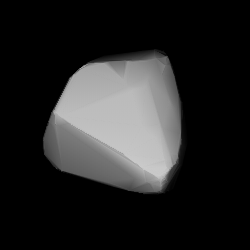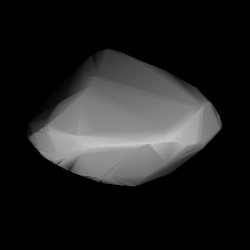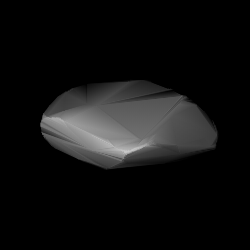Related Research Articles
2159 Kukkamäki, provisional designation 1941 UX, is a stony asteroid from the inner region of the asteroid belt, approximately 11 kilometers in diameter. It was discovered on 16 October 1941, by Finnish astronomer Liisi Oterma at Turku Observatory in Southwest Finland. It was later named after Finnish geodesist Tauno Kukkamäki.

1552 Bessel, provisional designation 1938 DE1, is a stony Eoan asteroid from the outer regions of the asteroid belt, approximately 18 kilometers in diameter. It was discovered on 24 February 1938, by Finnish astronomer Yrjö Väisälä at Turku Observatory in Southwest Finland, and named after German astronomer Friedrich Bessel.
Pawlowia, provisional designation 1923 OX, is a background asteroid from the central regions of the asteroid belt, approximately 20 kilometers in diameter. It was discovered on 5 October 1923, by Soviet astronomer Vladimir Albitsky at the Simeiz Observatory on the Crimean peninsula. The asteroid was named after Russian physiologist and Nobelist Ivan Pavlov.
1191 Alfaterna, provisional designation 1931 CA, is a carbonaceous asteroid from the outer region of the asteroid belt, approximately 43 kilometers in diameter. It was discovered on 11 February 1931, by Italian astronomer Luigi Volta at the Observatory of Turin in northwestern Italy. The asteroid was named for the ancient Roman town of Nuceria Alfaterna.
2033 Basilea, provisional designation 1973 CA, is a stony asteroid from the inner regions of the asteroid belt, approximately 6 kilometers in diameter. It was discovered on 6 February 1973, by astronomer Paul Wild at the Zimmerwald Observatory near Bern, Switzerland. The asteroid was named for the Swiss city of Basel.
1215 Boyer, provisional designation 1932 BA, is a stony Eunomian asteroid from the central region of the asteroid belt, approximately 20 kilometers in diameter. It was discovered by astronomer Alfred Schmitt in 1932, who named it after French astronomer and college Louis Boyer.
1541 Estonia, provisional designation 1939 CK, is an asteroid from the central regions of the asteroid belt, approximately 21 kilometers in diameter. It was discovered on 12 February 1939, by astronomer Yrjö Väisälä at the Iso-Heikkilä Observatory near Turku, Finland. The asteroid was named after the Baltic country of Estonia.
2016 Heinemann, provisional designation 1938 SE, is a carbonaceous Themistian asteroid from the outer regions of the asteroid belt, approximately 22 kilometers in diameter. It was discovered on 18 September 1938, by German astronomer Alfred Bohrmann at Heidelberg Observatory in southwest Germany, and later named after ARI-astronomer Karl Heinemann (1898–1970).
3785 Kitami, provisional designation 1986 WM, is a carbonaceous Themistian asteroid from the outer region of the asteroid belt, approximately 19 kilometers in diameter. The asteroid was discovered by Japanese astronomer Tsutomu Seki at Geisei Observatory on 30 November 1986, and named after the city of Kitami, Japan.
1522 Kokkola, provisional designation 1938 WO, is a stony Vestian asteroid from the inner regions of the asteroid belt, approximately 9.5 kilometers in diameter. It was discovered on 18 November 1938, by pioneering Finnish astronomer Liisi Oterma at Turku Observatory in Southwest Finland. It was later named for the town of Kokkola.

1361 Leuschneria, provisional designation 1935 QA, is a carbonaceous asteroid from the outer regions of the asteroid belt, approximately 30 kilometers in diameter. It was discovered on 30 August 1935, by Belgian astronomer Eugène Delporte at Uccle Observatory in Belgium, and named after American astronomer Armin Otto Leuschner.
1771 Makover, provisional designation 1968 BD, is a carbonaceous asteroid from the outer region of the asteroid belt, approximately 50 kilometers in diameter.
2043 Ortutay, provisional designation 1936 TH, is a dark asteroid from the outer regions of the asteroid belt, approximately 45 kilometers in diameter. The asteroid was discovered by Hungarian astronomer György Kulin at the Konkoly Observatory, Budapest, on 12 November 1936. It was named after Hungarian ethnographer Gyula Ortutay.
1857 Parchomenko, provisional designation 1971 QS1, is a stony asteroid and suspected binary from the inner regions of the asteroid belt, approximately 8 kilometers in diameter.
1536 Pielinen, provisional designation 1939 SE, is a stony Florian asteroid from the inner regions of the asteroid belt, approximately 7.8 kilometers in diameter. It was discovered on 18 September 1939, by Finnish astronomer Yrjö Väisälä at Turku Observatory, Southwest Finland. It was later named for Finnish lake Pielinen.

1186 Turnera, provisional designation 1929 PL, is a stony Eoan asteroid from the outer regions of the asteroid belt, approximately 36 kilometers in diameter. It was discovered on 1 August 1929, by South African astronomer Cyril Jackson at the Union Observatory in Johannesburg. The asteroid was later named after British astronomer Herbert Hall Turner.

1704 Wachmann, provisional designation A924 EE, is a stony asteroid from the inner regions of the asteroid belt, approximately 7 kilometers in diameter. It was discovered by German astronomer Karl Reinmuth at Heidelberg Observatory on 7 March 1924. It was later named after astronomer Arno Wachmann.

1542 Schalén, provisional designation 1941 QE, is a background asteroid from the outer region of the asteroid belt, approximately 45 kilometers in diameter. It was discovered on 26 August 1941, by Finnish astronomer Yrjö Väisälä at Turku Observatory in Southwest Finland. The dark D-type asteroid was later named after Swedish astronomer Karl Schalén.

1632 Sieböhme, provisional designation 1941 DF, is an asteroid and relatively slow rotator from the middle region of the asteroid belt, approximately 27 kilometers in diameter. It was discovered on 26 February 1941, by German astronomer Karl Reinmuth at Heidelberg Observatory in southern Germany. It was later named after ARI-astronomer Siegfried Böhme.
1573 Väisälä, provisional designation 1949 UA, is a stony Phocaea asteroid, slow rotator and suspected tumbler from the inner regions of the asteroid belt, approximately 9 kilometers in diameter. It was discovered on 27 October 1949, by Belgian astronomer Sylvain Arend at the Royal Observatory of Belgium in Uccle, Belgium. It was named for Finnish astronomer Yrjö Väisälä.
References
- 1 2 3 4 "JPL Small-Body Database Browser: 1412 Lagrula (1937 BA)" (2016-06-16 last obs.). Jet Propulsion Laboratory . Retrieved 9 January 2017.
- 1 2 3 Schmadel, Lutz D. (2007). "(1412) Lagrula". Dictionary of Minor Planet Names – (1412) Lagrula. Springer Berlin Heidelberg. p. 114. doi:10.1007/978-3-540-29925-7_1413. ISBN 978-3-540-00238-3.
- 1 2 3 4 5 6 "LCDB Data for (1412) Lagrula". Asteroid Lightcurve Database (LCDB). Retrieved 9 January 2017.
- 1 2 3 4 Nugent, C. R.; Mainzer, A.; Bauer, J.; Cutri, R. M.; Kramer, E. A.; Grav, T.; et al. (September 2016). "NEOWISE Reactivation Mission Year Two: Asteroid Diameters and Albedos". The Astronomical Journal. 152 (3): 12. arXiv: 1606.08923 . Bibcode:2016AJ....152...63N. doi: 10.3847/0004-6256/152/3/63 . S2CID 119289027.
- 1 2 3 Masiero, Joseph R.; Grav, T.; Mainzer, A. K.; Nugent, C. R.; Bauer, J. M.; Stevenson, R.; et al. (August 2014). "Main-belt Asteroids with WISE/NEOWISE: Near-infrared Albedos". The Astrophysical Journal. 791 (2): 11. arXiv: 1406.6645 . Bibcode:2014ApJ...791..121M. doi:10.1088/0004-637X/791/2/121. S2CID 119293330 . Retrieved 9 January 2017.
- 1 2 3 Mainzer, A.; Grav, T.; Masiero, J.; Hand, E.; Bauer, J.; Tholen, D.; et al. (November 2011). "NEOWISE Studies of Spectrophotometrically Classified Asteroids: Preliminary Results". The Astrophysical Journal. 741 (2): 25. arXiv: 1109.6407 . Bibcode:2011ApJ...741...90M. doi:10.1088/0004-637X/741/2/90. S2CID 118700974.
- 1 2 3 4 5 6 7 Casalnuovo, Giovanni Battista (October 2013). "Lightcurve Photometry, H-G Parameters and Estimated Diameter for 1412 Lagrula". The Minor Planet Bulletin. 40 (4): 188. Bibcode:2013MPBu...40..188C. ISSN 1052-8091 . Retrieved 9 January 2017.
- 1 2 Aznar Macias, Amadeo; Carreno Garcerain, Alfonso; Arce Masego, Enrique; Brines Rodriguez, Pedro; Lozano de Haro, Juan; Fornas Silva, Alvaro; et al. (July 2016). "Twenty-one Asteroid Lightcurves at Group Observadores de Asteroides (OBAS): Late 2015 to Early 2016". The Minor Planet Bulletin. 43 (3): 257–263. Bibcode:2016MPBu...43..257A. ISSN 1052-8091 . Retrieved 9 January 2017.
- 1 2 Veres, Peter; Jedicke, Robert; Fitzsimmons, Alan; Denneau, Larry; Granvik, Mikael; Bolin, Bryce; et al. (November 2015). "Absolute magnitudes and slope parameters for 250,000 asteroids observed by Pan-STARRS PS1 - Preliminary results". Icarus. 261: 34–47. arXiv: 1506.00762 . Bibcode:2015Icar..261...34V. doi:10.1016/j.icarus.2015.08.007. S2CID 53493339 . Retrieved 9 January 2017.
- 1 2 "1412 Lagrula (1937 BA)". Minor Planet Center. Retrieved 9 January 2017.
- ↑ Schmadel, Lutz D. (1997). Dictionary of Minor Planet Names – Introduction, Source of Information. Springer Berlin Heidelberg. p. 16. ISBN 978-3-662-06617-1 . Retrieved 9 January 2017.